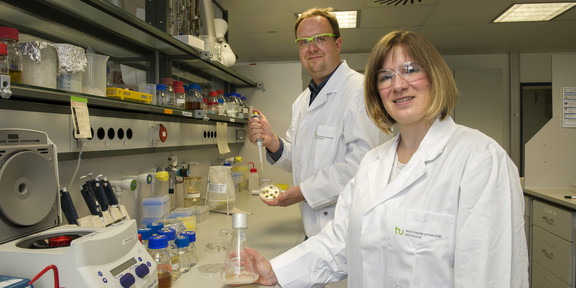Unique Innovation Worldwide: TU Dortmund University Produces Nicotine-Free Tobacco
- Research
- Top News
- Press Releases

Dr. Felix Stehle (42) of TU Dortmund University has succeeded, in collaboration with Julia Schachtsiek (29), in lowering harmful nicotine in tobacco down to detection limit. Instead of 16 milligrams, each gram of tobacco now contains only 0.04 milligrams of nicotine, a reduction by a factor of 400. On 22 September, Dr. Stehle presented this innovation, which is unique worldwide, to experts at the InterTabac trade fair in Dortmund, by its own account the world’s leading exhibition for tobacco goods and smoking accessories.
That precisely the tobacco industry is interested in this topic is quite astonishing, finds Stehle, but at the same time logical: “With nicotine-free cigarettes, manufacturers could open up an additional market for themselves,” he says, “namely the target group of smokers who would like to give up as well as people who want to keep to their usual smoking habits but at the same time avoid harmful nicotine.” That is why Stehle was asked to present his development at the exhibition after an article he and his colleague had submitted appeared in the Plant Biotechnology Journal in June.
The development of the nicotine-free tobacco demanded three years of intensive research work. First, Stehle and Schachtsiek soaked leaves of the Virginia Smoking Tobacco plant in petri dishes in a bacterial solution containing CRISPR gene scissors. First of all, the scissors cut through the six genes of the tobacco plant that are responsible for nicotine production. Although the plant then put these genes back together again, it built in a defect – which meant the genes remained disabled. As a consequence, the plants were no longer able to produce nicotine. The research team then removed the gene scissors from the plant again, creating a “new” nicotine-free tobacco plant. “In our view, once treatment is completed the plant is GMO-free,” says Stehle. There is, however, an EU ruling dated July 2018 that prohibits the cultivation of such plants in Europe. For this reason, Stehle considers that the market for this nicotine-free type of tobacco lies not in Europe but above all overseas.
Seedlings grew in the labs of the Faculty of Biochemical and Chemical Engineering
The Stehle/Schachtsiek team would need about 18 months if companies wanted them to free their own particular type of tobacco of nicotine. The plants were treated in the labs of the Faculty of Biochemical and Chemical Engineering and the seedlings were cultivated in the basement of the faculty’s buildings on North Campus, where they grew in controlled conditions under artificial light. “Tobacco is a beautiful plant with large green leaves and pale-pink flowers,” says Stehle ardently.
Stehle stopped smoking about seven years ago and Julia Schachtsiek never started. Incidentally, they are exploding a myth: The cigarettes previously sold as “light” by no means contained less nicotine than normal cigarettes. Instead, they had a filter that added air to the cigarette smoke as the smoker inhaled and thus reduced the nicotine content of that particular draw on the cigarette. However, the cigarette itself contained just as much nicotine as a normal one. This was also the reason why – following legal disputes – light cigarettes disappeared from the market.
Paper: Schachtsiek Julia, Stehle Felix: Nicotine-free, nontransgenic tobacco (Nicotiana tabacum l.) edited by CRISPR-Cas9. Plant Biotechnol J. 2019 Jun 17. doi: 10.1111/pbi.13193.





![[Translate to English:] Partner Four hands are holding the green logo of TU Dortmund University](/storages/tu_website/_processed_/1/d/csm_Partner_Nicole_Rechmann_KW_40b35bb3fd.jpg)




![[Translate to English:] Forschung An apparatus with tubes in a laboratory](/storages/tu_website/_processed_/0/c/csm_Forschung_Juergen_Huhn_cbd34afd6d.jpg)
![[Translate to English:] Studium Five students are sitting in a lecture hall. They are talking to each other.](/storages/tu_website/_processed_/c/9/csm_Studium_FelixSchmale_81d94adc86.jpg)





